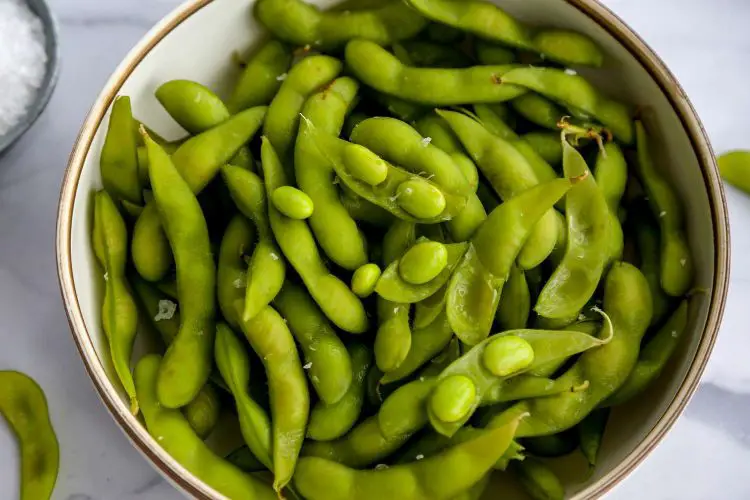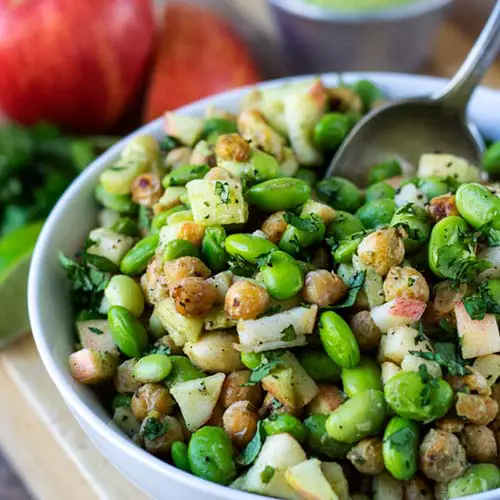Edamame and Mukimame are both types of soybeans that are considered “healthy” because they are low in fat and high in protein.
They can be bought canned, frozen, or fresh.
In this blog post, I will show you the difference between them both, the different ways to eat edamame and mukimame, as well as some of the health benefits they offer. Stay tuned!
Contents
What Is the Difference Between Edamame and Mukimame?
The main difference between mukimame and edamame is that mukimame refers to the actual beans that have been removed from their pods while edamame refers to immature soybeans found inside their pods.
So, although they may look similar, they are actually two distinct foods with different culinary uses.
Mukimane can be used in salads, stir-fries, soups, stews, or simply boiled in salted water and served as a side dish like traditional Japanese cuisine calls for.
Meanwhile, edamame can be steamed as an appetizer or snack or added to salads or stir-fries for extra protein and flavor. Both are packed with nutrients such as fiber, vitamins A & C, iron, calcium, and protein – making them great additions to any healthy diet.
How Do You Eat Mukimame?
Mukimame can be eaten in a variety of ways. The beans can be boiled or steamed, which makes them great for salads, stir-fries, and other side dishes. They are also delicious when roasted, fried, or simmered in soups and stews.
Additionally, mukimame beans can be used to thicken sauces and purees or to make dips like hummus. They can also be blended into smoothies for a protein-packed kick.
Finally, mukimame beans are perfectly enjoyable on their own as a snack. You can simply boil them for a few minutes, season them with salt, and enjoy!
Are Mukimame Beans Good for You?
Mukimame beans are incredibly nutritious and make a great addition to any diet. They are an excellent source of plant-based protein, fiber, vitamins, minerals, and antioxidants.
Studies have shown that mukimame beans can help lower cholesterol levels, reduce the risk of certain diseases, improve digestion and gut health, and even help with weight management.
In addition to their health benefits, mukimame beans are easy to prepare and make a delicious, versatile ingredient for meals and snacks.
For those looking for an extra nutritious boost, adding mukimame beans to your diet is a great choice!
What Goes Well With Edamame?
Edamame goes well with a variety of ingredients, making it an incredibly versatile ingredient. It pairs especially well with Asian flavors such as garlic, ginger, sesame oil, soy sauce, and rice vinegar.

It also complements the flavor of vegetables like mushrooms, bell peppers, and carrots. Edamame can be used as a topping for dishes such as ramen, fried rice, and stir-fries.
You can also add edamame to salads, soups, grain bowls, or purees. It is also delicious when added to pasta dishes or served with fish and other proteins.
Finally, edamame can be enjoyed as a snack on its own, boiled or steamed and seasoned with salt.
No matter what you decide to pair it with, edamame always adds some extra nutrition and flavor to your meal!
Why Is Edamame Poisonous?
Edamame is not poisonous in itself and can be enjoyed safely.
However, it is important to note that the pods of edamame should not be eaten as they contain a neurotoxin called glucosinolate which can be harmful if ingested.
The toxin is concentrated mainly within the hulls of the pods, so it is important to remove the hulls before eating edamame. If the edamame bean is cooked, it will also be safe to eat.
In conclusion, edamame is a nutritious and delicious food that can easily be integrated into any diet. As long as you take care to remove the pods and not consume them, you can enjoy edamame safely.
It is also important to note that, despite the similar name and appearance, mukimame beans are not poisonous and do not contain glucosinolate. They can be eaten in their entirety with no risk of harm.
Which Is Healthier Edamame or Chickpeas?
Both edamame and chickpeas are incredibly nutritious, so it is hard to say which one is the healthier option.
Both contain a variety of essential vitamins, minerals, and plant-based proteins that can provide numerous health benefits.

Edamame contains more folate than chickpeas, as well as slightly more vitamin C and iron. Chickpeas, on the other hand, contain more dietary fiber than edamame.
In terms of calories, a one-cup serving of edamame contains around 189 calories while chickpeas have 264 calories per cup.
Ultimately, choosing between edamame and chickpeas comes down to personal preference. Both are healthy, nutritious options that can be enjoyed in many different ways.
What Is the Healthiest Bean in the World?
The healthiest bean in the world is debatable, as there are many different beans that offer numerous health benefits.
However, some of the most nutritious and beneficial beans include mung beans, lentils, black beans, chickpeas, navy beans, and edamame.
These beans provide a good source of plant-based proteins, dietary fibers, vitamins, minerals, and antioxidants.
Mung beans in particular are loaded with many health-promoting compounds such as vitamin C, magnesium, and folate. Lentils are a great source of plant proteins, iron, zinc, and potassium. Black beans contain high levels of fiber as well as calcium and magnesium.
Chickpeas are rich in folate and offer many other essential vitamins and minerals. Navy beans contain high levels of antioxidants, as well as essential fatty acids that can help reduce inflammation.
Finally, edamame is an excellent source of plant-based protein and several important nutrients such as vitamin K, iron, magnesium, and folate.
No matter which bean you choose, all of these are incredibly healthy and beneficial options that can help promote overall health and well-being.
Is Edamame Good for Your Gut?
Yes, edamame is good for your gut! It is a great source of dietary fiber, which can help to promote healthy digestion and regular bowel movements.
Edamame also contains prebiotic fibers that can help support the growth of beneficial bacteria in the gut. This can help to improve digestive health, reduce inflammation, and support the immune system.
In addition, edamame is rich in polyphenols and other antioxidants that can help reduce oxidative stress in the gut and protect against free radical damage.
What Is the Best Way to Cook Edamame?
The best way to cook edamame is to boil it. Boiling is a quick and easy cooking method that helps preserve the flavor and nutrition of edamame.
- To boil edamame, simply bring a pot of water to a rolling boil then add the edamame beans.
- Let them cook for about 4-5 minutes, or until they are tender but not mushy.
- Once cooked, strain the beans and rinse them in cold water to stop the cooking process.
Edamame can also be steamed or stir-fried if desired. However, boiling is generally considered to be the healthiest and most flavorful way to prepare edamame.
How Do You Cook Frozen Mukimame?
Mukimame, also known as edamame, is a type of green soybean that is popular in Japanese cuisine.
To cook frozen mukimame:
- Simply place the beans in a pot of boiling water and let them cook for about 4-5 minutes.
- Then strain the cooked beans and rinse them with cold water to stop the cooking process.
Or you can just follow the tutorial below:
You may also steam or stir-fry the frozen mukimame if desired. When adding it to other dishes, add the beans towards the end of the cooking process so they don’t become overcooked.
Mukimame can be served as a side dish or added to salads, soups, stir-fries, and more. They are a great source of plant-based proteins and other essential nutrients.
What Can I Do With Edamame Shells?
Edamame shells are not just for throwing away! In fact, there are many creative ways to reuse them. Here are some of the most popular:
• Make a delicious broth by boiling the shells in water and straining them out afterward. The resulting broth is packed with flavor and can be used as a base for soups, stews, stir-fries, and more.
• Use the shells to add a crunchy texture to salads or grain bowls.
• Add them to smoothies or shakes for added nutrition.
• Make your own plant-based protein powder by grinding the shells into a powder in a food processor.
• Use them as a topping for yogurt, oatmeal, or ice cream.
Edamame shells are incredibly versatile and can be used in many different recipes to add flavor, texture, and nutrition. So don’t throw them away — put them to good use!
What Is the Best Way to Eat Edamame?
Edamame is incredibly versatile and can be enjoyed in many different ways. The best way to eat edamame will depend on your personal preference.
Some of the most popular ways to enjoy edamame include as a snack, added to salads or grain bowls, stirred into soups or stir-fries, added to sandwiches or wraps, and even used as the base for a plant-based protein powder.
No matter how you choose to enjoy edamame, it is sure to be an incredibly healthy and delicious addition to your diet!
Are You Supposed to Eat the Whole Edamame?
Yes, you can eat the whole edamame bean, including the shell. The shells are edible and are high in fiber, which can help promote regular digestion and bowel movements.
You can also remove the shells if desired — simply pinch one end of the pod between your thumb and forefinger and then slide it off.
This is an especially good option for dishes where a smoother texture is desired, such as soups or smoothies.
Are Edamame Beans Fattening?
No, edamame beans are not fattening. In fact, they are incredibly healthy and packed with essential nutrients.
Edamame beans contain a good amount of protein and dietary fiber, both of which can help you feel full for longer and aid in weight management. They also contain monounsaturated fats, which are the “good” kind of fats that can help promote heart health.
Overall, edamame beans are a healthy and nutritious addition to any diet! Enjoy them as a snack or in your favorite recipes for an extra boost of nutrition.
What Flavors Go With Edamame?
Edamame beans have a mild, nutty flavor that pairs well with many ingredients. Some flavors that go well with edamame include garlic, ginger, sesame oil, soy sauce, lime juice, and chili peppers.
Edamame can also be combined with other vegetables to create flavorful side dishes. Try adding it to a stir-fry with other vegetables such as bok choy, carrots, and bell peppers.
For a healthy snack, try roasting edamame with olive oil, salt, and pepper. Or add it to salads for an extra boost of protein and flavor.
Is Raw Edamame Poisonous?
No, raw edamame is not poisonous. In fact, raw edamame beans are a great source of essential nutrients and contain many health benefits.
That said, it is important to make sure that the edamame you buy has been cooked properly. Undercooked edamame can be hard and difficult to eat, so it is best to buy pre-cooked edamame or cook the beans until they are tender and easy to bite into.
Remember, raw edamame can be enjoyed in moderation as part of a healthy diet! Enjoy them as a snack or added to your favorite recipes for an extra boost of nutrition.
Why Should You Not Eat Edamame Pods?
The edamame pods themselves are not edible and should not be eaten. The pods are tough and can be difficult to digest, so it is best to remove them before eating the beans.
However, the pods can still be used in other ways — for example, you can use them to make a plant-based stock or broth, which can be used in soups and stews.
The pods are also great for adding flavor to dishes such as rice or quinoa.
Conclusion:
In conclusion, the main difference between mukimane and edamame lies in how they are prepared; mukimame refers to the actual beans that have been removed from their pods while edamame refers to immature soybeans found inside their pods.
Whichever type of bean you choose to enjoy, both edamame and mukimame are packed with protein, vitamins, minerals, and fiber that can help keep you healthy.
They’re also low in calories and fat, making them a great choice for those looking to lose weight or maintain a healthy lifestyle.
So, if you’re looking for an exciting way to add some extra nutrition to your diet, why not give edamame or mukimame beans a try? You’re sure to be pleasantly surprised!
Amazon and the Amazon logo are trademarks of Amazon.com, Inc, or its affiliates.

